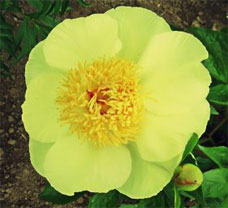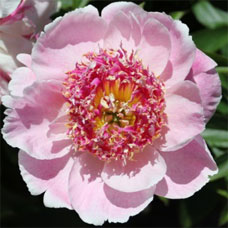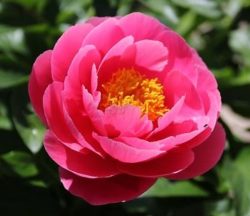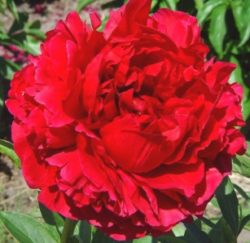A Multitude of Form
Peony flowers are astounding in size, shape, form and structure
The flower forms of peonies are wide and varied. Each flower form presents intrigue, beauty and contemplation for the viewer. The American Peony Society’s official standard includes six forms – Single, Japanese, Anemone, Semi-double, Bomb and Full double. These have for long been the commonly recognized classifications in North America and, for the most part, in Europe. The American Peony Society has officially maintained this standard terminology to bring order and continuity for describing peony flowers commonly grown in our gardens. Other regional systems exist in practice and in publication, but are neither used nor recognized by APS in any official capacity. See Addtional Resources below for more information.

Single
Typically resembles the wild form with 5 or more petals, pollen bearing stamens, and functional carpels. Singles in cultivation may have up to 15 petals but still be classed as Singles, provided the petals are spread in a saucer shape – rather than being cup-shaped, ruffled, or otherwise giving the impression of a noticeable third dimension, which have been used to justify applying the Semidouble classification, instead.

Japanese
Diagnostic of Japanese flower form are the staminodes. These are abortive or transformed stamens in which their origin is still recognizable. Edges of the staminodes are thickened and often contain viable pollen, but it is encased in tissue and not otherwise available. The original peonies of this form were imported from Japan where the lack of pollen drop was a wanted feature.

Anemone
Stamen transformation in the anemone form has progressed toward petal characteristics to the point where all visible evidence of stamen origin, except for yellow color, has disappeared. These structures are termed petalodes, being the transitional form between staminodes and inner petals. In some kinds these petalodes are very narrow, and yellow, giving contrast comparable to that of the Japanese form flower. On others the petalodes will be larger. As size is further increased, the transformed segments become longer, wider, and take on the texture and color of the guard petals, leading to the Bomb flower form.

Bomb
The width and length to which the inner segments have progressed in size is such they have become inner petals, almost always the same color as the guards. Overall effect is a ball sitting on a plate, the plate being formed of the larger guard petals at the base of the flower, and the inner petals forming the ball. This center ball will vary in size in different Bomb form cultivars, Red Charm and Mons. Jules Elie are examples.

Semi-Double
Quite a range of variations are included in this designation. They have in common prominent stamens, and a bulking of the petalage, through combinations of traits: partial transformation of stamens into inner petals, multiplication of petals, or petals structure which add visual bulk to the flower.

Full Double
In the ultimate expression of this form, all stamens and carpels are transformed into petals. Nevertheless stamens are allowed, provided they are obscure, can scarcely be seen or not at all, without manually separating petals. Peony cultivars of this class are almost always of two-stage (flower-in-flower) anatomy, presumably accounting for genesis of the term “Double” in traditional peony dialogue. The two-stage anatomy accounts for the greater amount of petals seen in Full Doubles. When pollen-bearing stamens occur in these flowers they will be found in a thin ring at the margin of the lower flower and in a small tuft embedded at center.

